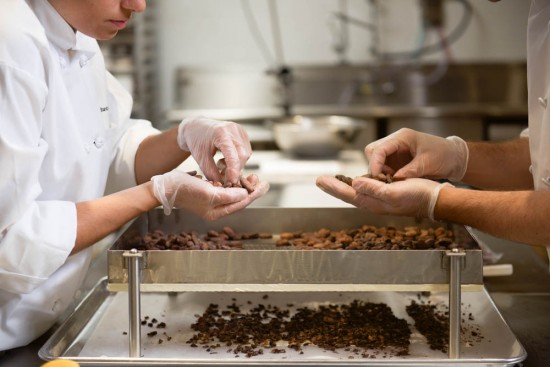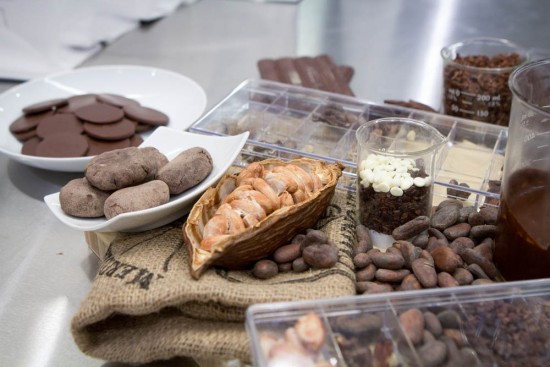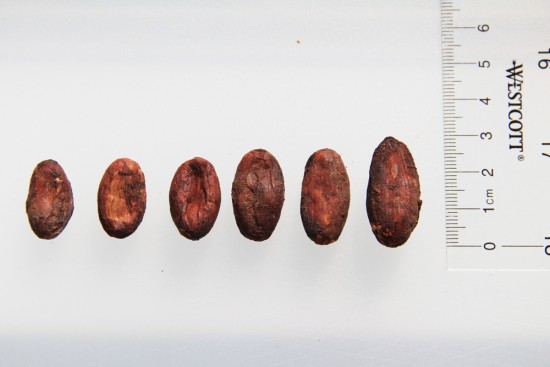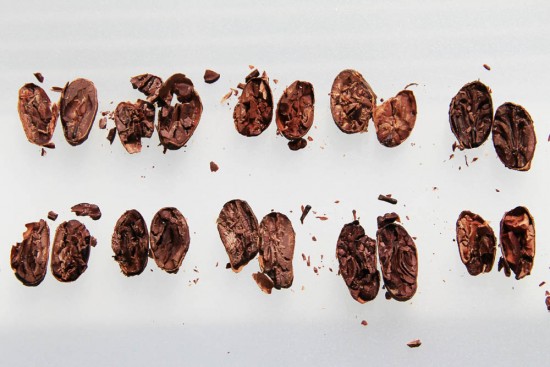It may sound obvious, but the first step in the chocolate making process is bean selection. No two beans are alike, each offering distinctive flavor characteristics impacted by genetics, origin, farming and post-harvest handling—before they ever arrive at a chocolate production facility.
Of course, individual chocolate makers are presented with numerous opportunities to imprint their personal stamp on the finished product during the chocolate making process, but to create an exceptional product, the best strategy is often to highlight the inherent qualities of the raw bean itself.

Most popular texts on the subject of cacao divide beans into three primary varietals. However the latest research reveals that this classification is overly simplistic and somewhat flawed. With so much genetic cross-pollination, hybridization, mutation and recombination, it is rare and increasingly difficult to find any pure forms of the primary bean varietals.
Modern commercial production is based on the conventional knowledge of these primary genetic clusters, known as Criollo, Forastero and Trinitario (a hybrid of the previous two). Forastero dominates world production, accounting for 90% of the cacao grown and often referred to as “bulk” cacao, as opposed to “fine” or “flavor” cacao, which indicates the Criollo and Trinitario types. In the last decade, scientists have sought to refine and expand the longstanding classification to a dozen or more genetic sub-clusters that include such names as Amelonado, Beniano, Marañon and Purús.
Adding further complexity are commercial breeds with sterile sounding names, such as CCN-51 or EET-103. The pursuit of these more detailed classifications isn’t in vain: the clearer our understanding of a particular bean’s genetic heritage, the easier it is to understand its ultimate potential.
When it comes to sourcing beans, large-scale manufacturers—and a growing number of small-batch artisans—work directly with farmers to understand a particular lot of beans and even influence its quality. The latter is especially true when it comes to the crucial fermentation stage, which takes place on the cacao plantation itself.
Fermentation lasts from five to seven days, varying both by bean type and by the specifications dictated by the manufacturer purchasing the beans. Pods are harvested manually by making a clean cut through the stalk with a well-sharpened blade. After the ripe pod has been cut from the tree, it is opened, the rind is discarded and the pulp and seeds are piled in boxes or laid out in mounds for several days.

During this time, the pulp liquefies and the process of fermentation takes place, through the action of wild yeasts and bacteria that convert the natural sugars in the pulp into alcohol and acids (lactic and acetic). This allows complex chemical changes to take place within the bean, including enzyme activity, oxidation and the breakdown of proteins into amino acids.
These chemical reactions lead to the development of characteristic chocolate flavors, aromas and colors. Interestingly, just as house-fermented products are gaining traction throughout the culinary landscape, a deeper interest in fermentation is expanding in the cacao industry. Increasingly, beans are being inoculated with very specific cultures, manually influencing processes that happen spontaneously in tropical cacao-growing regions.
Another crucial processing step—and one that shouldn’t be overlooked—is drying, when the bean’s moisture content falls from about 60% to roughly 7.5%. The reduced moisture of the beans inhibits mold growth after they are packed and shipped—typically overseas. Beans are dried by two methods: the preferable option is to dry the beans in the sun, but in some regions artificial means are employed, such as heat provided by a wood or gas fire.
A classic example of the latter takes place in Papua New Guinea, where the harvest coincides with the rainy season. As such, Guinean beans ferment under unusually humid conditions, and the necessity of oven drying imparts the beans with a slightly smoky flavor. When beans initially arrive in the ICE Chocolate Lab, I make a quick study of the type and origin, applying as many general assumptions as I can.
Beans of similar genetic background can express themselves differently from region to region, so it’s helpful to have as much additional knowledge as possible. While there may be no optimal treatment that can be applied to all beans, insights provided by knowledge of the cultivar and growing conditions can steer the chocolate maker, for example, toward a lighter or heavier roast. There are also visual cues an experienced chocolate maker can use to assess bean quality and guide the process.

Bean size will influence roasting time and temperature, so a bean count per 100 grams is a common method of expressing size, which can vary greatly even within a single lot. Recent lots of beans I have personally received for the lab include tiny Bolivian beans that averaged nearly 90 per 100 grams, to larger Peruvian beans where the count was closer to 70.
Beyond bean type and size, I also consider the beans’ degree of fermentation. To assess this, I split open random samples of beans to assess for color (as well as for slaty or moldy beans). In such a cut test, beans with a purple hue may be slightly under-fermented while the color will deepen to various shades of brown with more fermentation.
After sifting through a few batches of different beans, one can easily begin to understand how bean selection alone factors into an approach to chocolate making, demanding its own set of parameters. Learning to assess bean characteristics has been an important first step in my chocolate education, from deeper-flavored Forastero beans from Ghana to the fruity notes typical of Madagascar beans.
We’ve encountered unexpected results in the ICE lab, as with one particular lot of beans from the Dominican Republic that provided a distinct aroma of licorice—not unpleasant, but not at all what we expected to find from that origin. On the other hand, samples of beans from Ecuador’s Camino Verde—where various cultures and fermentation techniques are employed—all expressed varying notes while still aligning with the typical floral aromas we associate with the region.

Each bean we’ve sourced requires different handling—from roasting through to winnowing, refining and conching—in order to fully express the inherent qualities that lie within. One of our most recent chocolate batches was a first attempt with beans from Papua New Guinea developed as part of a two-day professional development class.
The subtle smokiness—a result of oven drying, as mentioned above—carried through to the finished bar and was not unlike a complex, peaty Scotch whiskey. The most exciting part of working in our modern age of small-batch chocolate is that these kinds of characteristics—which, historically, may have been viewed as defects—add a unique profile and a distinct sense of place.
With time and experience, seasoned chocolate makers can intuitively identify subtle nuances beneath the rough bitter overtones of simple roasted nibs or coarsely ground liquor. Even with all my hours in ICE’s Chocolate Lab, guessing at a finished chocolate’s final flavor is not a skill I’ve fully mastered. In my career as a pastry chef, few projects have offered as much opportunity for personal development and discovery.
From the complexities of crafting true-to-character single-origin chocolates to exploring the art of blending different beans for balanced, consistent batches, I’m eager to continue this journey in craftsmanship. Beginning to understand the process from harvest to shipping is daunting, but it opens up a whole new range of possibilities to expand my palate, refine my skills and cultivate students’ intellectual discovery of one of the world’s most beloved food products.
Click here to watch a video about the ICE Chocolate Lab.




